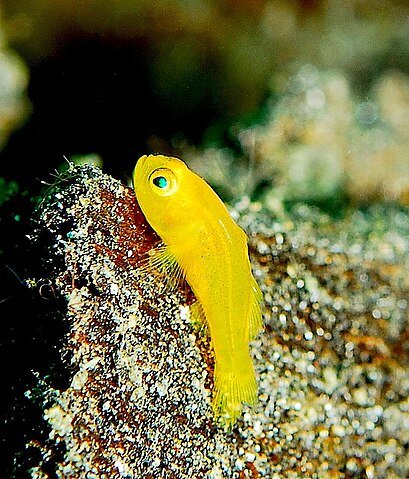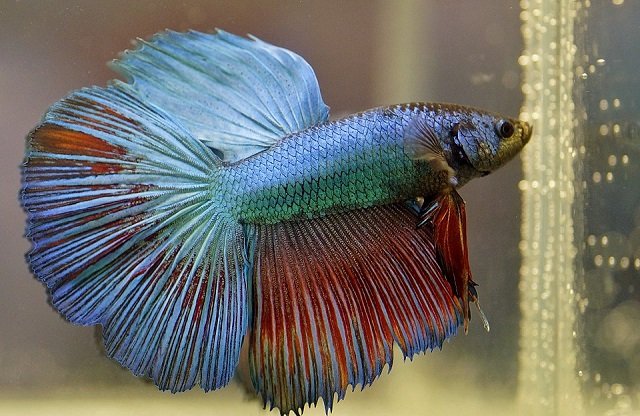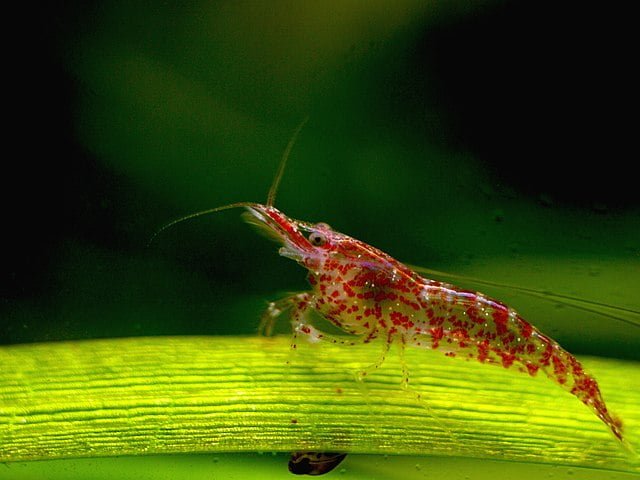
The Yellow Clown Goby (Gobiodon okinawae) is a small, vibrant, and charismatic fish that has become a popular choice for marine aquariums. Its bright yellow color and peaceful behavior make it stand out in any reef tank. Gobiodon okinawae is considered one of the least vulnerable species to overexploitation in the aquarium trade (Dee et al., 2019).
In this comprehensive guide, we will explore everything you need to know about the Yellow Clown Goby, including its care requirements, diet, lifespan, and whether it is reef-safe. We will also discuss the breeding of Gobiodon okinawae and the ideal conditions to keep it healthy and happy.
What is the Yellow Clown Goby (Gobiodon okinawae)?
- 1 What is the Yellow Clown Goby (Gobiodon okinawae)?
- 2 Habitat and distribution
- 3 Care of Gobiodon okinawae
- 4 Compatibility with other fish
- 5 Feeding the Yellow Clown Goby
- 6 Reproduction of the Yellow Clown Goby
- 7 Is the Yellow Clown Goby Reef-Safe?
- 8 Common diseases of the Yellow Clown Goby
- 9 Conclusion
- 10 References
- 11 Entradas relacionadas:
Taxonomy
Gobiodon okinawae, or the Yellow Clown Goby, is one of the most popular and outgoing species of the Gobiodon genus. Its taxonomy is as follows:
- Kingdom: Animalia
- Phylum: Chordata
- Class: Actinopterygii
- Subclass: Neopterygii
- Infraclass: Teleostei
- Order: Perciformes
- Family: Gobiidae
- Genus: Gobiodon
- Species: Gobiodon okinawae (Sawada, Arai & Abe, 1972)
- Common names in Spanish: Gobio payaso amarillo, Gobio de Okinawa, Gobio de coral, Gobio coral amarillo.
- Common name in English: Yellow Clown Goby
Characteristics
The Yellow Clown Goby (Gobiodon okinawae) is a small marine fish native to coral reefs in the Indo-Pacific. It belongs to the Gobiidae family and is known for its compact body, intense yellow color, and ability to adapt well to home aquariums.
- Size: Approximately 3.5 cm (1.5 inches) long.
- Color: Bright yellow.
- Behavior: Peaceful, sometimes shy.
- Compatibility: Ideal for reef aquariums with corals.
- Lifespan: Between 2 and 5 years. However, Randall and Delbeek (2009) reported a specimen that reached 13 years of age in a public aquarium.
This fish is an excellent choice for small and community aquariums, as it does not require a large space and generally coexists well with other peaceful fish.
Habitat and distribution
Gobiodon okinawae is found in coral reefs throughout the western Pacific, from Japan to Indonesia. It prefers to live in shallow (2–12 m) and warm waters (20–25°C) and is commonly found in groups (5–15 individuals) within Acropora corals (Schubert et al., 2003).

Care of Gobiodon okinawae
Caring for a Gobiodon okinawae is not complicated, but there are some key aspects to consider to ensure its well-being.
Table 01. Water quality parameters for the care of the Yellow Clown Goby (Gobiodon okinawae).
Stay Always Informed
Join our communities to instantly receive the most important news, reports, and analysis from the aquaculture industry.
| Parameter | Range |
|---|---|
| Tank Size | 40 liters (10 gallons) for a single specimen. 80 liters (20 gallons) when kept with other fish. |
| Water Temperature | 24-28°C (75-82°F). |
| Salinity | 1.020-1.025 sg. |
| Water pH | 8.1-8.4. |
| Carbonate Hardness (dKH) | 8-12°dKH. |
| Ammonia and Nitrites | 0 ppm. |
| Nitrates | Less than 20 ppm. |
| Water Change | 25% per week. |
Decoration and hiding spots
OATA (2022) reports that gobies feel safer when they have corals and hiding places to retreat to. They prefer hard corals (such as Acropora), where they perch and find protection.
Compatibility with other fish
The Yellow Clown Goby is peaceful but may become territorial with other gobies. It should not be kept with aggressive or predatory fish, as its small size makes it vulnerable.
Feeding the Yellow Clown Goby
The diet of the Yellow Clown Goby (Gobiodon okinawae) is a crucial aspect of its health and longevity. In the wild, these fish are carnivorous and feed on small crustaceans, zooplankton, and parasites found on corals. In captivity, their diet should be varied and nutritious.
Recommended foods:
- Frozen foods: Artemia, mysis, and cyclops are excellent options.
- Live foods: Copepods and artemia nauplii are ideal for stimulating their natural hunting behavior.
- Dry foods: They accept high-quality flakes and pellets, though these should not be their primary food source.
Feeding frequency:
Feed your Yellow Clown Goby 2-3 times a day in small amounts. Ensure the food is small enough for them to consume easily.
Reproduction of the Yellow Clown Goby
Breeding Gobiodon okinawae in captivity is possible but requires patience and specific conditions. Cole and Hoese (2001) report that Gobiodon okinawae exhibits bidirectional hermaphroditism, where individuals can switch between male and female roles. According to the researchers, individuals initially develop as females and later either remain functional females or become hermaphrodites.
Reproduction process:
- Pair formation: Once a pair is established, the male looks for a flat surface to lay eggs, such as a rock or coral base.
- Egg laying: The female deposits the eggs, which the male fertilizes and guards until they hatch.
- Hatching: The fry emerge after 5-7 days and must be fed with plankton and rotifers.
Raising Yellow Clown Goby fry in home aquariums is challenging, as they are very small and require specialized feeding.
Is the Yellow Clown Goby Reef-Safe?
This fish is generally reef-safe but may cause issues with certain corals.
Does It harm corals?
Unlike other fish, Gobiodon okinawae does not feed on corals, but it may irritate them by perching on them. In tanks with SPS corals (such as Acropora), this behavior can be problematic if the fish stays on a single colony for too long.
Recommendations:
- If you have a reef tank with sensitive corals, provide multiple structures so the goby does not settle on just one coral.
- Avoid mixing them with corals that could harm them with stinging tentacles.
Common diseases of the Yellow Clown Goby
Gobiodon okinawae is a hardy fish but may develop diseases if water conditions are not optimal.
Common diseases:
- White Spot Disease (Ich): May occur if the fish is stressed. Treat with water changes and specific medications.
- Bacterial Infections: Can arise from open wounds. Treat with appropriate antibiotics.
- Loss of Appetite: May indicate stress or poor water quality.
To prevent diseases, it is essential to maintain a clean environment and provide a varied, nutritious diet.
Conclusion
The Yellow Clown Goby (Gobiodon okinawae) is a vibrant and easy-to-care-for fish in well-established marine aquariums. Its bright color, peaceful behavior, and reef compatibility make it an excellent choice for aquarists of all levels.
However, it is important to understand its specific needs regarding diet, compatibility, and reproduction, as well as its lifespan.
If you’re looking for a striking and easy-to-maintain fish, the Yellow Clown Goby can be the perfect addition to your aquarium. Just ensure you provide a suitable environment and balanced diet to enjoy its beauty for many years.
References
Cole, K.S., Hoese, D.F. Gonad Morphology, Colony Demography and Evidence for Hermaphroditism in Gobiodon Okinawae (Teleostei, Gobiidae). Environmental Biology of Fishes 61, 161–173 (2001). https://doi.org/10.1023/A:1011032228716
Dee, L. E., Karr, K. A., Landesberg, C. J., & Thornhill, D. J. (2019). Assessing Vulnerability of Fish in the U.S. Marine Aquarium Trade. Frontiers in Marine Science, 5, 426824. https://doi.org/10.3389/fmars.2018.00527
OATA. (September 2022). How to care for gobies. 7 p.
Randall, J. E., & Delbeek, J. C. (2009). Comments on the extremes in longevity in fishes, with special reference to the Gobiidae. Proceedings of the California Academy of Sciences, 60(10), 447.
Schubert, M., Munday, P. L., Caley, M. J., Jones, G. P., & Llewellyn, L. E. (2003). The toxicity of skin secretions from coral-dwelling gobies and their potential role as a predator deterrent. Environmental Biology of Fishes, 67, 359-367.
Editor at the digital magazine AquaHoy. He holds a degree in Aquaculture Biology from the National University of Santa (UNS) and a Master’s degree in Science and Innovation Management from the Polytechnic University of Valencia, with postgraduate diplomas in Business Innovation and Innovation Management. He possesses extensive experience in the aquaculture and fisheries sector, having led the Fisheries Innovation Unit of the National Program for Innovation in Fisheries and Aquaculture (PNIPA). He has served as a senior consultant in technology watch, an innovation project formulator and advisor, and a lecturer at UNS. He is a member of the Peruvian College of Biologists and was recognized by the World Aquaculture Society (WAS) in 2016 for his contribution to aquaculture.




